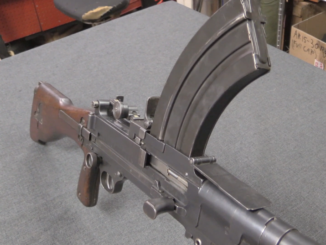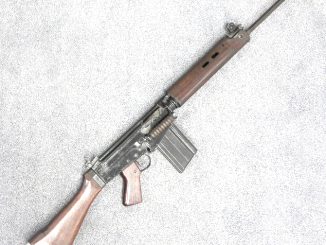The Vickers-Berthier MkIII was adopted by the Indian army in 1933, and served through World War Two and into the 1970s (at least). It is chambered for the standard .303 British cartridge, fires from an open bolt, and uses top-mounted 30-round magazines. I didn’t know exactly what to expect when I had the chance to fire this one – and it turned out the be an excellent experience.
The rate of fire on the Vickers-Berthier is relatively low, and I found it to be an exceptionally stable and controllable gun to fire from its bipod. I don’t know if it’s the unusual muzzle brake design or other factors as well, but the sight picture remains stable and clear in a way that few other LMGs have matched in my experience.
Thanks to Marstar for letting me examine and shoot their Vickers-Berthier!




Well, the Vickers Berthier is a bit heavier than the Bren so maybe that extra mass helps along with the muzzle brake in recoil buffering. On a side note a Lewis gun without a cooling shroud would need a muzzle brake to mitigate recoil impulses (especially if it’s bolted to an airplane gunner’s ring mount).
Ian, I am interested in your background. You seem to be capable in engineering and well versed in history. Do you have a degree in one or the other – or both? I am an engineer and I appreciate your demonstrations of how the guns are designed. From your videos, I have an understanding of the evolution of the firearms, although it is somewhat disjointed. Is there a book which shows this evolution? If not, how about writing one?
“Is there a book which shows this evolution?”
Here: http://www.ibiblio.org/hyperwar/USN/ref/MG/
you can read The Machine Gun
History, Evolution, and Development of Manual, Automatic, and
Airborne Repeating Weapons
which shows evolution of machine guns
How is this legal in Canada? There’s a 5 round mag limit and the Firearms Act forbids Authorizations to Transport (ATT) Prohibited long guns to ranges. Was the range used part of the store?
Marstar is a gun shop that can sell “Prohibited Weapons” in Canada.
The LMG could be legal but not the 6 round + mags. It’s also not legal to take prohibited long arms to a range so how does Marstar get around the Firearms Act? Is it pretending it’s doing some sort of gunsmithing test fire?
This is what I was wondering about couple of numbers back. Theoretically inaccessible to 99% 0f certified gun possessors but still viable. Exceptions rule; very Canadian, eh.
Now we are talking…. and turning attention back to subject of show. Very nice indeed; that muzzle break makes wonders.
You said that its development started early 1900, but when was it at this level? Could the US Marines for instance almost had a lmg that was way ahead of its time?
http://www.acant.org.au/Articles/VickersMGs.html states that Berthier machine gun has originally peculiar cooling system, unlike anything ever used on any other weapon. The barrel of the gun was contained within a jacket to which, at either end, was attached a rubber tube connected to a bulb, one of which was filled with water. As the barrel heated, squeezing the bulb containing water propelled the water through the space between the barrel and the jacket into the other bulb. The water could then be squeezed back again as the need for further barrel cooling arose.
I don’t think that system could handle any serious field conditions without bursting the cooling reservoirs. And the water would heat up through direct contact with the tubes anyway if the crew neglected to squeeze the bulbs. Even the Fiat-Revelli 1914 had a less problematic cooling system, consisting of a barrel jacket, two hoses, and a hand-cranked circulation pump connected to a cooling tank. The gun crew didn’t need to burn their hands while pumping water into the barrel jacket or out of it. Did I mess up?
While deficiencies of this system caused its abandonment it shows that at that time, designer either strive towards medium machine gun rather than LMG, either don’t trust air-cooling. If we would know mass of that weapon, we probably could answer which option.
Although its abandonment this system is worth noting as this weapon belong to rare category, it is gas-operated water-cooled rifle-caliber machine gun. From point-of-view of sealing water-jacking it is preferable to have fixed barrel (which can be achieved by using gas-operation) than moving barrel (like in Maxim and derivatives).
I would say that era of water-cooled rifle-caliber machine gun (time when new water-cooled machine gun, designed from scratch, entered production) ended with end of Great War in 1918, with late example of such machine gun being M1917 Browning. I would say era of gas-operated rifle-caliber machine gun started in 1895, year of adoption of Colt Potato Digger machine gun – first series production gas-operated rifle-caliber machine gun if I am not mistaken.
This give overlap of 23 years, but I am not aware of any another water-cooled rifle-caliber machine guns. I know some designers achieved fixed barrel without gas-operating (example: Kulspruta m/1914: http://www.gotavapen.se/gota/artiklar/utv_ksp58/ksp14/ksp14_1.htm using delayed-blow-back) but none gas-operated water-cooled rifle-caliber machine gun beyond Berthier.
Ian @ 2:56: “I like it!” 😉